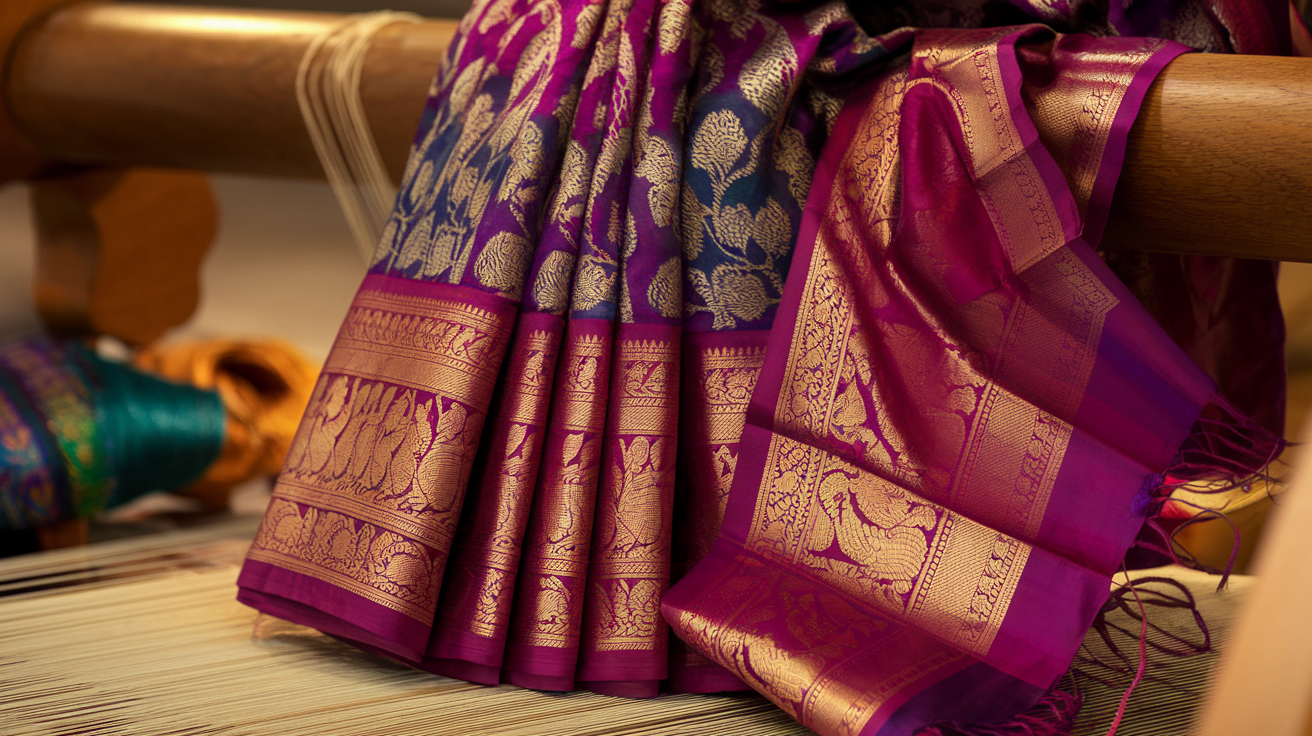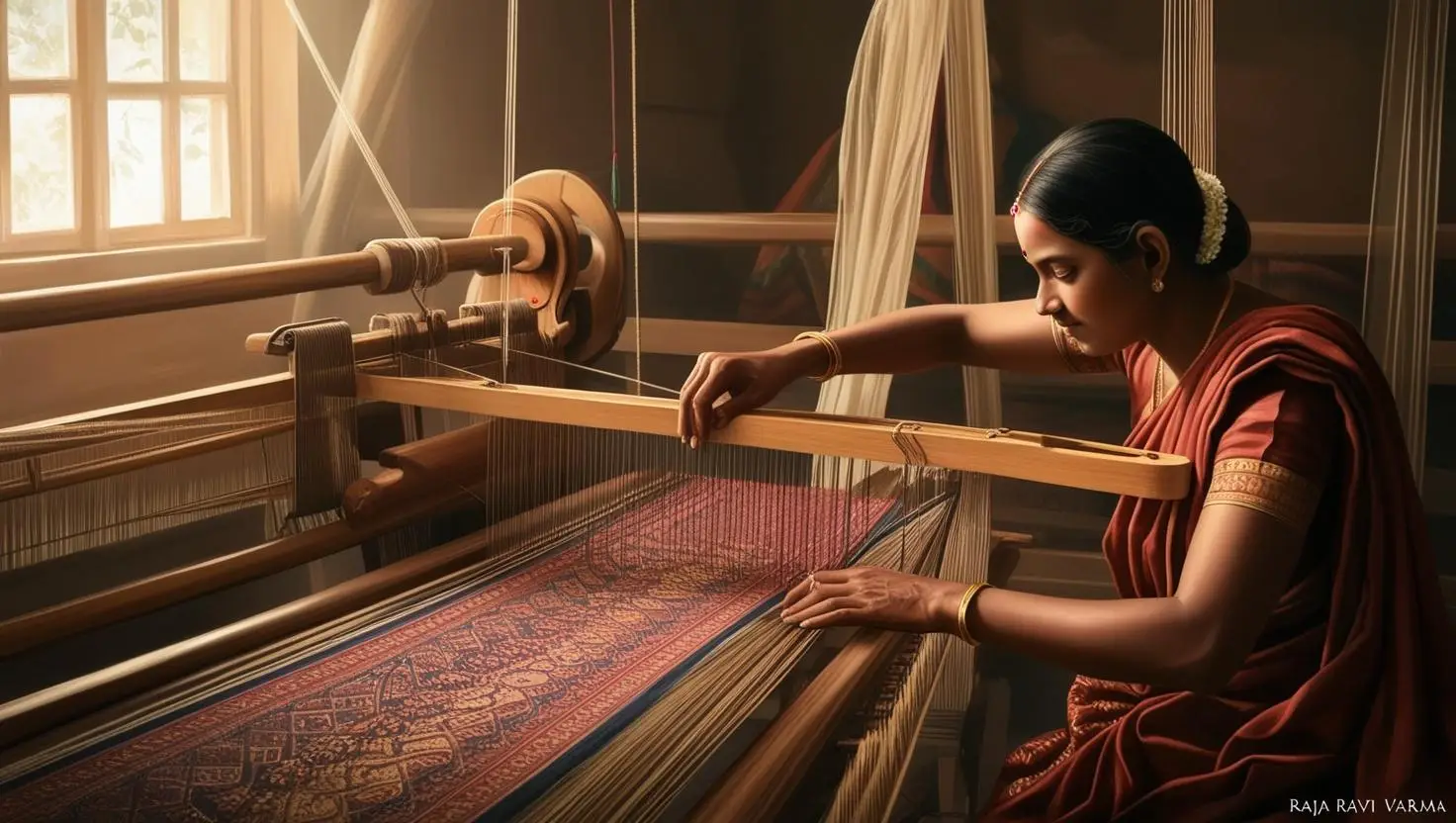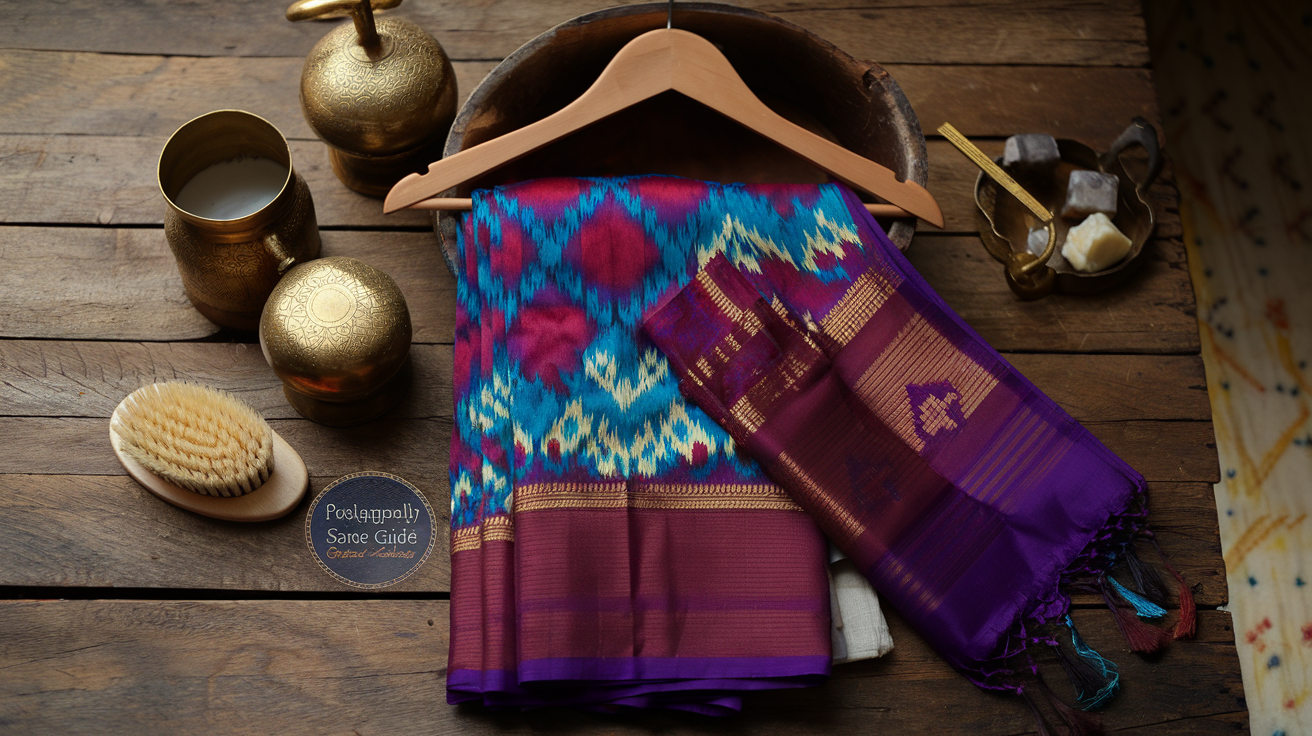In the realm of traditional Indian attire, few garments can rival the grandeur and elegance of a Kanchipuram saree. These exquisite silk creations, hailing from the temple town of Kanchipuram in Tamil Nadu, have captivated hearts for centuries with their unparalleled craftsmanship and regal allure. But what makes these sarees so special? 🤔
Beneath the shimmering surface of a Kanchipuram saree lies a fascinating world of artistry, science, and carefully guarded secrets. From the intricate zari work to the unique weaving techniques, every aspect of these sarees is steeped in tradition and skill. Yet, in today’s market flooded with imitations, how can one truly appreciate and identify an authentic Kanchipuram masterpiece?
This comprehensive guide will unravel the mystique surrounding Kanchipuram sarees, delving into their rich heritage, decoding the artistry behind their creation, and exploring the scientific principles that make them stand out. We’ll also reveal insider secrets of saree making, provide tips for identifying genuine pieces, and discuss ways to preserve these timeless treasures. Join us on this journey as we explore the art, science, and secrets of the iconic Kanchipuram saree. 🧵✨
The Rich Heritage of Kanchipuram Sarees
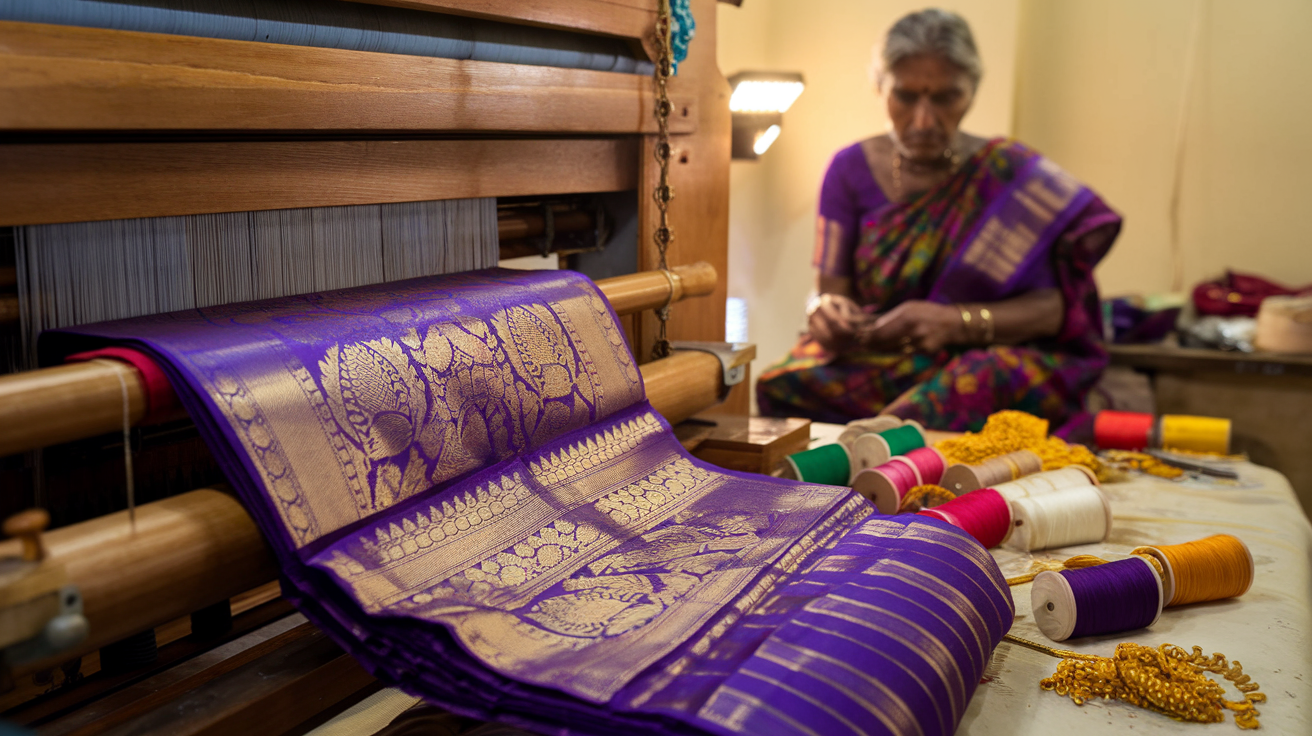
Origin and historical significance
The genesis of Kanchipuram sarees can be traced back to the ancient city of Kanchipuram, located in the southern Indian state of Tamil Nadu. This city, often referred to as the “City of a Thousand Temples,” has been a significant center of silk weaving for over two millennia. The art of weaving Kanchipuram sarees, also known as Kanjeevaram silk, is deeply intertwined with the region’s rich cultural and religious heritage.
The historical significance of Kanchipuram sarees is rooted in the city’s prominence as a major center of learning and spirituality during the Pallava dynasty (4th to 9th century CE). It was during this period that the art of silk weaving flourished, supported by royal patronage and the influx of skilled weavers from neighboring regions.
Key historical aspects of Kanchipuram sarees include:
- Royal patronage: The Pallava, Chola, and Vijayanagara rulers actively promoted the silk weaving industry, considering it a symbol of prestige and cultural refinement.
- Religious influence: The intricate motifs and designs found in Kanchipuram sarees often draw inspiration from the temple architecture and religious iconography of the region.
- Trade connections: Kanchipuram’s strategic location on ancient trade routes facilitated the exchange of weaving techniques and materials, contributing to the unique character of its silk sarees.
- Guild system: The establishment of weaver guilds, known as “pattu cheris,” played a crucial role in preserving and passing down the traditional weaving techniques through generations.
| Dynasty | Period | Contribution to Kanchipuram Sarees |
|---|---|---|
| Pallava | 4th-9th century CE | Establishment of silk weaving as a royal craft |
| Chola | 9th-13th century CE | Introduction of complex weaving techniques and motifs |
| Vijayanagara | 14th-17th century CE | Expansion of the silk industry and incorporation of gold thread |
The historical significance of Kanchipuram sarees extends beyond their aesthetic appeal, representing a living tradition that has withstood the test of time and continues to be an integral part of South Indian culture.
Evolution through centuries
The evolution of Kanchipuram sarees through the centuries is a testament to the adaptability and creativity of the weavers who have preserved this ancient art form. From its humble beginnings as a local craft to its current status as a globally recognized symbol of Indian textile heritage, the Kanchipuram saree has undergone significant transformations while maintaining its core identity.
Key milestones in the evolution of Kanchipuram sarees include:
- Ancient period (pre-4th century CE):
- Simple weaving techniques using locally available silk
- Limited color palette derived from natural dyes
- Basic geometric patterns and motifs
- Classical period (4th-13th century CE):
- Introduction of more complex weaving techniques
- Expansion of design repertoire, incorporating religious and floral motifs
- Use of gold thread (zari) for embellishment
- Medieval period (14th-17th century CE):
- Refinement of the double-warp weaving technique
- Introduction of contrasting borders and pallu designs
- Increased use of precious metals in the weaving process
- Colonial period (18th-19th century CE):
- Influence of European design elements
- Experimentation with new color combinations
- Mechanization of some aspects of the weaving process
- Post-independence era (20th century onwards):
- Revival of traditional designs and techniques
- Incorporation of modern motifs and color schemes
- Adaptation to changing consumer preferences
The evolution of Kanchipuram sarees can also be observed in the following aspects:
- Weaving techniques: From simple plain weaves to complex jacquard patterns
- Materials: Incorporation of high-quality mulberry silk and fine zari thread
- Colors: Expansion from traditional reds and golds to a diverse color palette
- Motifs: Evolution from basic geometric shapes to intricate figurative designs
| Period | Key Innovation | Impact on Kanchipuram Sarees |
|---|---|---|
| Ancient | Natural dye extraction | Limited but vibrant color palette |
| Classical | Gold thread incorporation | Enhanced luxury and prestige |
| Medieval | Double-warp technique | Increased durability and texture |
| Colonial | Jacquard loom adaptation | More complex and diverse patterns |
| Modern | Computer-aided design | Precision in intricate motifs |
Despite these changes, the core essence of Kanchipuram sarees has remained intact, preserving the traditional weaving techniques and cultural significance that make them unique.
Cultural importance in South Indian traditions
Kanchipuram sarees hold a position of unparalleled cultural importance in South Indian traditions, particularly in Tamil Nadu. These exquisite silk garments are not merely articles of clothing but are deeply interwoven with the social, religious, and ceremonial fabric of South Indian society. Their significance extends far beyond their aesthetic appeal, embodying centuries of tradition, craftsmanship, and cultural values.
Key aspects of the cultural importance of Kanchipuram sarees include:
- Wedding traditions:
- Considered auspicious for brides
- Often passed down as family heirlooms
- Symbolize the bride’s transition to married life
- Religious ceremonies:
- Worn during important temple rituals and festivals
- Offered as gifts to deities in temples
- Used in the adornment of temple idols
- Life cycle events:
- Marks significant milestones such as coming of age ceremonies
- Worn during naming ceremonies for newborns
- Part of the attire for funeral rites
- Social status:
- Indicator of family wealth and prestige
- Gifted during important social occasions
- Collected as a form of investment
- Cultural identity:
- Symbol of Tamil heritage and craftsmanship
- Featured in classical dance performances and folk art
- Represented in literature and popular media
The cultural significance of Kanchipuram sarees is further emphasized in various South Indian traditions:
- Gifting traditions: Presenting Kanchipuram sarees as gifts during weddings, housewarmings, and other auspicious occasions is a common practice, symbolizing respect and goodwill.
- Festive wear: These sarees are the preferred choice for major festivals like Diwali, Pongal, and Navaratri, reflecting the celebratory spirit of these events.
- Artistic inspiration: The motifs and designs of Kanchipuram sarees often inspire other art forms, including painting, sculpture, and architecture.
- Educational value: The process of creating Kanchipuram sarees is often used to teach younger generations about traditional craftsmanship and cultural heritage.
- Economic importance: The Kanchipuram saree industry supports thousands of artisans and their families, playing a crucial role in the local economy.
| Occasion | Significance of Kanchipuram Saree |
|---|---|
| Weddings | Symbol of marital bliss and prosperity |
| Temple visits | Expression of devotion and respect |
| Cultural performances | Representation of classical heritage |
| Diplomatic events | Showcase of Indian textile tradition |
| Family gatherings | Marker of special occasions and relationships |
The cultural importance of Kanchipuram sarees extends beyond their material value, serving as a tangible link to ancestral traditions and a source of pride for South Indian communities. As guardians of this rich heritage, weavers and artisans continue to play a vital role in preserving and promoting this timeless art form.
Now that we have explored the rich heritage of Kanchipuram sarees, including their origin, evolution, and cultural significance, we can delve deeper into the intricate artistry that makes these sarees truly exceptional and positive vibes.
Decoding the Artistry
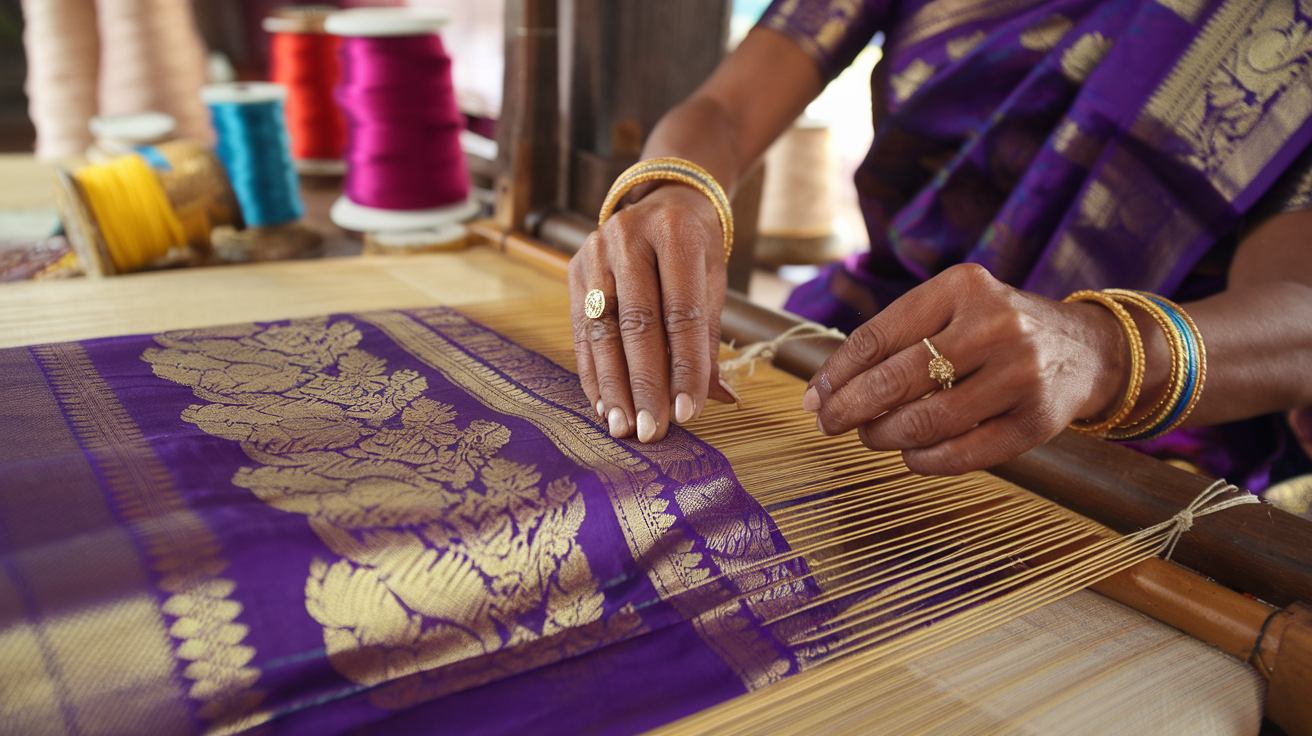
Unique weaving techniques
The artistry of Kanchipuram sarees lies in their distinctive weaving techniques, which have been perfected over centuries. These techniques contribute to the saree’s durability, luster, and overall aesthetic appeal.
One of the most notable aspects of Kanchipuram saree weaving is the use of pure mulberry silk and zari threads. The warp and weft are dyed separately before weaving, allowing for intricate color combinations and patterns. The weaving process involves a unique three-shuttle technique, where three shuttles are used simultaneously to create the body, border, and pallu of the saree.
Another hallmark of Kanchipuram sarees is the interlocking weave. This technique involves weaving the borders and pallu separately and then attaching them to the main body of the saree. This method ensures that even if the body of the saree wears out over time, the borders remain intact, preserving the saree’s value and beauty.
The weavers also employ a technique called ‘korvai,’ which involves weaving the border and body separately and then joining them with a zig-zag pattern. This not only adds to the saree’s strength but also creates a visually striking effect.
Here’s a comparison of Kanchipuram weaving techniques with other traditional Indian weaves:
| Technique | Kanchipuram | Banarasi | Chanderi |
|---|---|---|---|
| Silk Type | Pure mulberry silk | Silk, organza | Cotton-silk blend |
| Zari | Pure gold or silver | Gold, silver, copper | Minimal zari use |
| Weaving Method | Three-shuttle technique | Single shuttle | Single shuttle |
| Border Attachment | Korvai (interlocked) | Woven together | Woven together |
| Motif Complexity | Highly intricate | Intricate | Relatively simple |
Intricate motifs and their meanings
Kanchipuram sarees are renowned for their elaborate motifs, each carrying deep symbolic meanings rooted in Hindu mythology, nature, and local culture. These motifs are not merely decorative elements but serve as a visual language, telling stories and conveying beliefs.
Some of the most common motifs found in Kanchipuram sarees include:
- Peacock: Symbolizing grace, beauty, and royalty
- Mango (paisley): Representing fertility and abundance
- Lotus: Signifying purity and spiritual awakening
- Elephant: Denoting strength, wisdom, and good fortune
- Rudraksha: Representing Lord Shiva and spiritual enlightenment
- Temple designs: Showcasing the rich architectural heritage of South India
These motifs are often intricately woven using the contrasting zari thread, creating a stunning interplay of colors and textures. The placement and combination of these motifs are carefully planned to create a harmonious and balanced design across the saree.
Interestingly, the choice of motifs can also indicate the intended use of the saree. For instance, sarees with auspicious motifs like mangoes or peacocks are often preferred for weddings and other celebratory occasions, while those with more subtle designs might be used for everyday wear or less formal events.
Color symbolism in Kanchipuram sarees
Colors play a crucial role in the artistry of Kanchipuram sarees, with each hue carrying its own symbolic meaning and cultural significance. The choice of colors is not arbitrary but deeply rooted in Hindu traditions and South Indian culture.
Here’s a brief overview of color symbolism in Kanchipuram sarees:
- Red: Associated with marriage, prosperity, and fertility
- Green: Symbolizes growth, harmony, and nature
- Yellow: Represents knowledge, learning, and auspiciousness
- Blue: Signifies tranquility, depth, and stability
- Purple: Denotes royalty, luxury, and power
- Gold: Symbolizes wealth, prosperity, and divine blessings
The combination of colors in a Kanchipuram saree is carefully chosen to create a visually striking effect while also conveying specific meanings. For example, a red and gold combination is particularly popular for bridal sarees, symbolizing prosperity and auspiciousness.
Weavers often use contrasting colors for the body and border of the saree, creating a striking visual impact. This color contrast is achieved through the unique three-shuttle weaving technique, allowing for distinct color sections within the saree.
The role of zari work
Zari work is an integral part of Kanchipuram saree artistry, adding a touch of opulence and grandeur to these already exquisite garments. Zari refers to the fine gold or silver thread used to create intricate patterns and designs on the saree.
Traditionally, Kanchipuram sarees used pure gold zari, which contributed to their high value and prestige. Today, while pure gold zari is still used in some high-end sarees, silver-coated copper wire is more commonly used due to its cost-effectiveness and durability.
The zari work in Kanchipuram sarees serves several purposes:
- Enhancing visual appeal: The metallic sheen of zari creates a stunning contrast against the silk background, making the saree more visually striking.
- Adding texture: Zari work adds a tactile dimension to the saree, creating raised patterns that can be felt as well as seen.
- Increasing value: The amount and quality of zari work significantly influence the saree’s overall value and prestige.
- Conveying symbolism: Zari is often used to create auspicious motifs and patterns, adding to the saree’s symbolic significance.
The zari work in Kanchipuram sarees is known for its durability and longevity. Even after years of use, the zari retains its luster, a testament to the skill of the weavers and the quality of materials used.
Different types of zari work found in Kanchipuram sarees include:
- Butti work: Small, repeated motifs scattered across the saree
- Jaal work: An all-over network of intricate patterns
- Border work: Elaborate zari designs along the saree’s borders
- Pallu work: Extensive zari detailing on the pallu (end piece) of the saree
The artistry of Kanchipuram sarees is a perfect blend of traditional techniques, symbolic elements, and skilled craftsmanship. From the unique weaving methods to the intricate motifs, vibrant colors, and exquisite zari work, every aspect of these sarees is carefully designed to create a garment that is not just beautiful, but also deeply meaningful. This rich artistry has ensured that Kanchipuram sarees remain a cherished part of Indian cultural heritage, continuing to captivate wearers and admirers alike with their timeless elegance.
The Science Behind the Weave
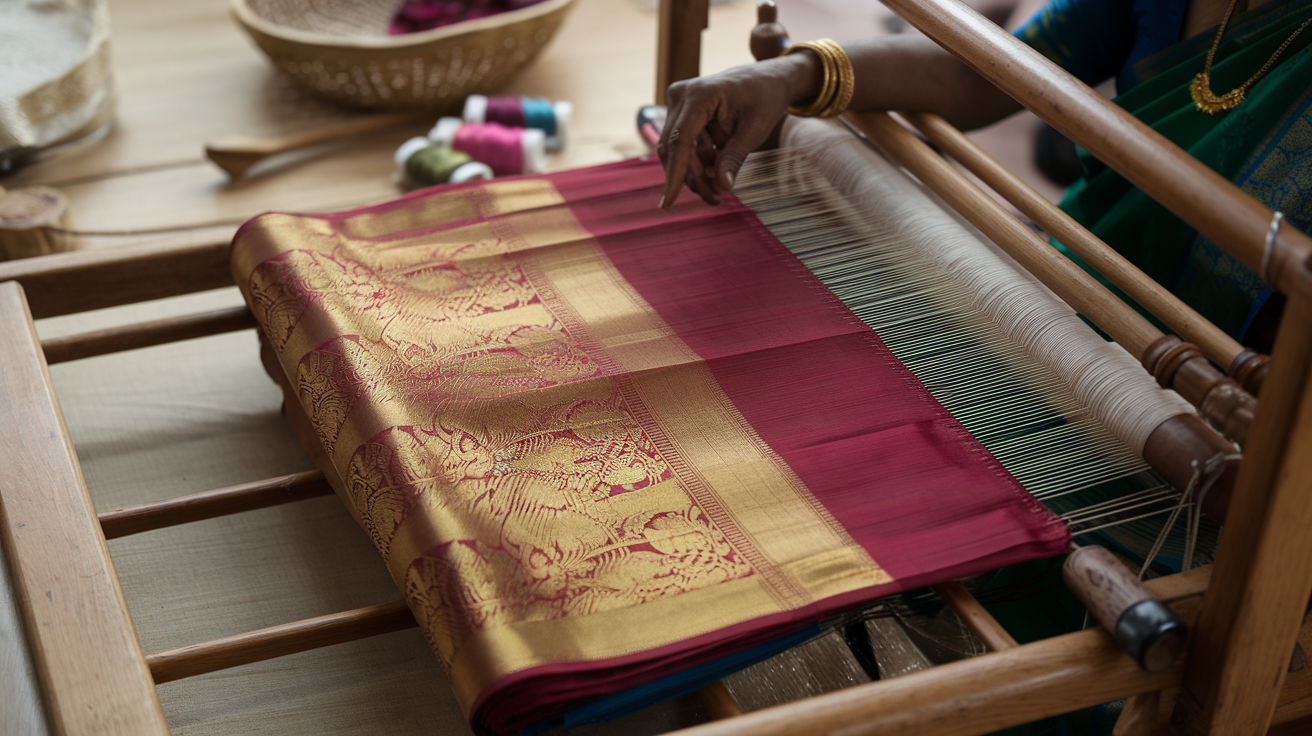
Silk Production Process
The journey of a Kanchipuram saree begins with the production of high-quality silk. This process is as intricate as the final product itself, involving several stages that ensure the creation of the finest silk threads.
- Sericulture: The foundation of silk production
- Mulberry cultivation
- Silkworm rearing
- Cocoon formation
- Reeling: Extracting silk from cocoons
- Boiling cocoons
- Unwinding filaments
- Combining multiple filaments
- Throwing: Preparing silk for weaving
- Twisting threads
- Creating different yarn types
- Strengthening the silk
The silk used in Kanchipuram sarees is known for its durability and lustrous sheen. This quality is achieved through a meticulous production process that has been perfected over centuries.
| Stage | Process | Outcome |
|---|---|---|
| Sericulture | Rearing silkworms on mulberry leaves | Raw silk cocoons |
| Reeling | Unwinding cocoons in hot water | Raw silk filaments |
| Throwing | Twisting and combining filaments | Strong, uniform silk thread |
The silk threads used in Kanchipuram sarees are typically thicker than those used in other silk fabrics, contributing to the saree’s characteristic weight and drape.
Dyeing Techniques and Natural Colors
The vibrant hues of Kanchipuram sarees are achieved through traditional dyeing techniques that have been passed down through generations. These methods not only create stunning colors but also ensure the longevity of the saree’s appearance.
Natural Dye Sources
- Vegetable dyes
- Turmeric for yellow
- Indigo for blue
- Madder root for red
- Mineral dyes
- Iron oxide for brown and black
- Copper sulfate for green
- Insect-derived dyes
- Lac for deep red
- Cochineal for bright red and purple
The use of natural dyes contributes to the eco-friendly nature of Kanchipuram saree production. However, synthetic dyes are also used in modern production to achieve a wider range of colors and improve color fastness.
Dyeing Process
- Preparation of dye bath
- Pre-treatment of silk threads
- Immersion and boiling
- Fixation of color
- Washing and drying
The dyeing process is crucial in determining the final appearance of the saree. Master dyers use their expertise to achieve the perfect shade and ensure that the color penetrates the silk fibers thoroughly.
The Mechanics of the Loom
The traditional handloom used in Kanchipuram saree weaving is a marvel of engineering, combining simplicity with precision. These looms have evolved over centuries but retain their fundamental design.
Key Components of the Kanchipuram Loom
- Warp beam: Holds the lengthwise threads
- Heddles: Guide the warp threads
- Reed: Separates and aligns warp threads
- Shuttle: Carries the weft thread
- Treadles: Control the movement of heddles
The unique feature of Kanchipuram saree weaving is the use of three shuttles. This allows for the incorporation of zari (gold or silver thread) into the body and border of the saree simultaneously.
Weaving Technique
- Setting up the warp
- Threading the heddles
- Passing the weft
- Creating patterns through different weave structures
- Interlocking the body and border
The interlocking technique used in Kanchipuram sarees sets them apart from other silk sarees. This method involves weaving the body and border separately and then joining them using a unique interlocking weave, resulting in a saree that will not fray even if the border is detached.
| Weave Structure | Description | Typical Use |
|---|---|---|
| Plain weave | Simple over-under pattern | Saree body |
| Twill weave | Diagonal pattern | Decorative elements |
| Satin weave | Smooth, lustrous surface | Borders and motifs |
The complexity of the weave and the incorporation of zari contribute to the weight of Kanchipuram sarees, which can range from 200 to 2000 grams depending on the design and amount of zari used.
Quality Control Measures
Maintaining the high standards associated with Kanchipuram sarees requires stringent quality control measures throughout the production process.
Raw Material Inspection
- Silk thread quality assessment
- Uniformity
- Strength
- Luster
- Zari thread verification
- Purity of metal content
- Evenness of plating
Weaving Process Monitoring
- Tension control
- Ensures even weave
- Prevents warping
- Pattern accuracy
- Regular checks against design template
- Correction of any deviations
- Knot and defect detection
- Visual inspection during weaving
- Immediate rectification of issues
Final Product Evaluation
- Visual inspection
- Color consistency
- Pattern alignment
- Border and pallu integrity
- Physical tests
- Fabric weight measurement
- Drape assessment
- Zari content verification
- Durability tests
- Color fastness to washing and light
- Tensile strength testing
These quality control measures ensure that each Kanchipuram saree meets the high standards expected of this prestigious weave. The Geographical Indication (GI) tag awarded to Kanchipuram sarees further necessitates adherence to specific quality parameters.
The science behind the Kanchipuram saree weave is a testament to the ingenuity of Indian textile traditions. From the careful cultivation of silkworms to the precise mechanics of the loom, every step in the process contributes to the creation of a garment that is not just clothing, but a work of art. As we move forward, we’ll explore the closely guarded secrets that make Kanchipuram saree making a truly unique craft.
Secrets of Kanchipuram Saree Making
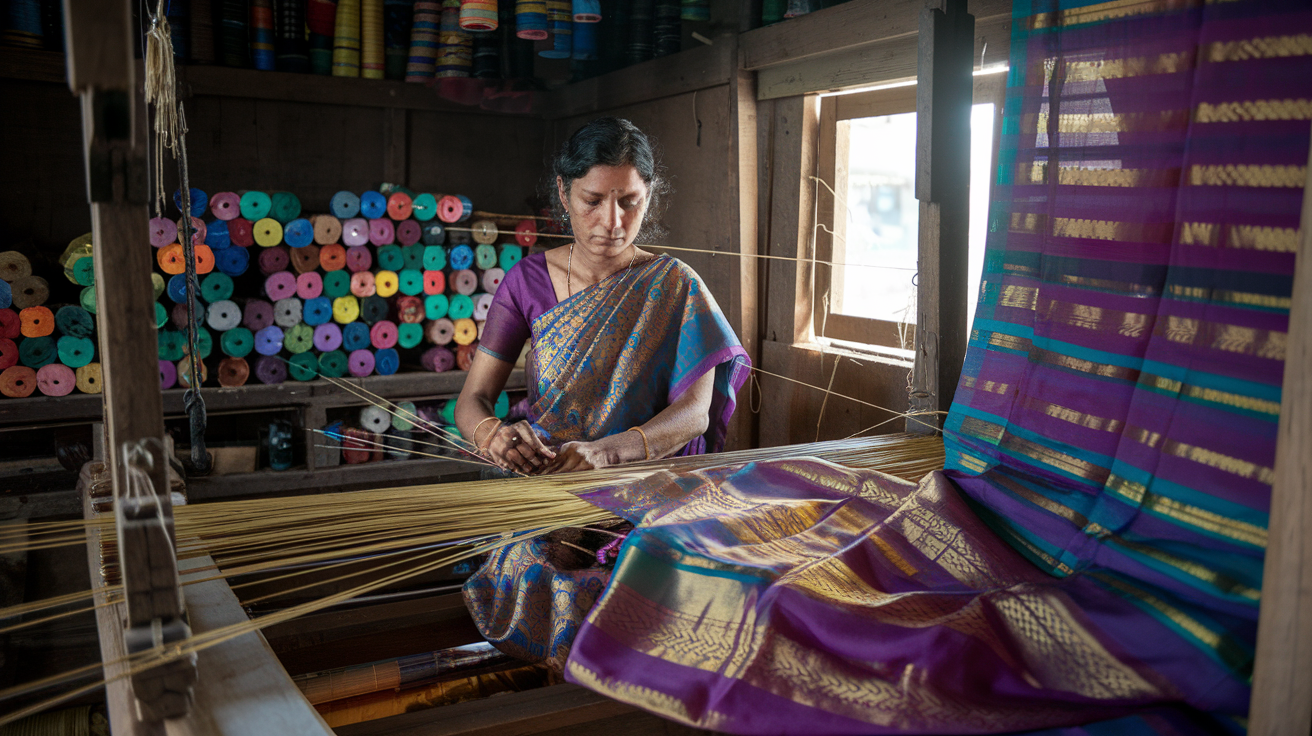
Traditional knowledge passed through generations
The creation of Kanchipuram sarees is an art form that has been meticulously preserved and passed down through generations of skilled artisans. This traditional knowledge forms the backbone of the Kanchipuram saree making process, ensuring that the authenticity and quality of these revered garments remain intact.
Master weavers in Kanchipuram have long relied on oral traditions to transmit their expertise to younger generations. This method of knowledge transfer encompasses various aspects of saree making, including:
- Silk selection and preparation
- Dyeing techniques
- Weaving patterns
- Zari work
- Finishing touches
Let’s explore these elements in more detail:
| Aspect | Traditional Knowledge |
|---|---|
| Silk Selection | Identifying high-quality mulberry silk by touch and appearance |
| Dyeing | Natural dye extraction and application methods |
| Weaving | Intricate patterns and motifs specific to Kanchipuram |
| Zari Work | Techniques for incorporating gold and silver threads |
| Finishing | Methods for enhancing durability and shine |
This wealth of traditional knowledge ensures that each Kanchipuram saree is a masterpiece, reflecting centuries of craftsmanship and cultural heritage.
The art of blending colors and patterns
One of the most captivating aspects of Kanchipuram sarees is the harmonious blend of colors and patterns that adorn them. This artistry is not merely a matter of aesthetic choice but a carefully cultivated skill that master weavers have refined over generations.
The color palette of Kanchipuram sarees is rich and diverse, often drawing inspiration from nature, mythology, and cultural symbolism. Some key elements in the art of color blending include:
- Contrasting borders: A hallmark of Kanchipuram sarees, where the body and border colors create a striking visual impact
- Gradients: Subtle shifts in color tones that add depth and dimension to the saree
- Complementary hues: Skillful pairing of colors that enhance each other’s vibrancy
Patterns in Kanchipuram sarees are equally significant, often telling stories or representing cultural motifs. The art of combining these patterns involves:
- Balancing intricate and simple designs
- Incorporating auspicious symbols and motifs
- Adapting traditional patterns to contemporary tastes
Master weavers often experiment with various color and pattern combinations, creating unique pieces that stand out while maintaining the essence of Kanchipuram’s weaving tradition.
Hidden techniques of master weavers
Behind the scenes of Kanchipuram saree making lie a treasure trove of hidden techniques that master weavers employ to create these exquisite garments. These closely guarded secrets contribute to the uniqueness and superior quality of Kanchipuram sarees.
Some of these hidden techniques include:
- Double warp weaving: This technique involves using two warp threads instead of one, significantly enhancing the durability and weight of the saree.
- Korvai weaving: A complex method where the body and border of the saree are woven separately and then joined seamlessly, allowing for contrasting colors and patterns.
- Petni weaving: This technique creates a reversible saree with different patterns on each side, showcasing the weaver’s exceptional skill.
- Zari interlock: A method of interlocking zari threads to create intricate designs that appear three-dimensional.
- Temple border creation: The iconic temple border of Kanchipuram sarees is crafted using a special technique that requires precision and expertise.
These techniques, among others, are what set Kanchipuram sarees apart from other silk sarees and contribute to their enduring appeal.
Innovations in design while maintaining authenticity
While Kanchipuram sarees are steeped in tradition, the craft has not remained static. Master weavers and designers have found ways to innovate and adapt to changing tastes while preserving the essence of this timeless weave.
Some notable innovations include:
- Contemporary motifs: Incorporating modern design elements alongside traditional patterns to appeal to younger generations.
- Lightweight variants: Creating lighter Kanchipuram sarees that retain the signature look and feel but are more comfortable for everyday wear.
- Eco-friendly practices: Adopting sustainable dyeing methods and exploring alternatives to chemical-based dyes.
- Fusion designs: Blending Kanchipuram weaving techniques with other Indian textile traditions to create unique hybrid sarees.
- Technology integration: Using computer-aided design (CAD) for pattern creation while maintaining hand-weaving for the actual production.
These innovations demonstrate the adaptability of Kanchipuram saree making, ensuring its relevance in the modern fashion landscape while honoring its rich heritage.
The secrets of Kanchipuram saree making are a testament to the skill, creativity, and dedication of generations of weavers. From the traditional knowledge passed down through families to the hidden techniques that elevate these sarees to works of art, every aspect of the creation process is infused with expertise and passion.
As we’ve explored the intricate world of color blending, pattern design, and innovative approaches, it becomes clear why Kanchipuram sarees continue to captivate and inspire. These secrets not only contribute to the sarees’ unparalleled beauty and quality but also ensure the preservation of a cultural legacy.
With this deep understanding of the craftsmanship behind Kanchipuram sarees, we can better appreciate their value and significance. As we move forward, it’s crucial to consider how to identify authentic Kanchipuram sarees, ensuring that this rich tradition continues to thrive and be recognized for its true worth.
Identifying Authentic Kanchipuram Sarees
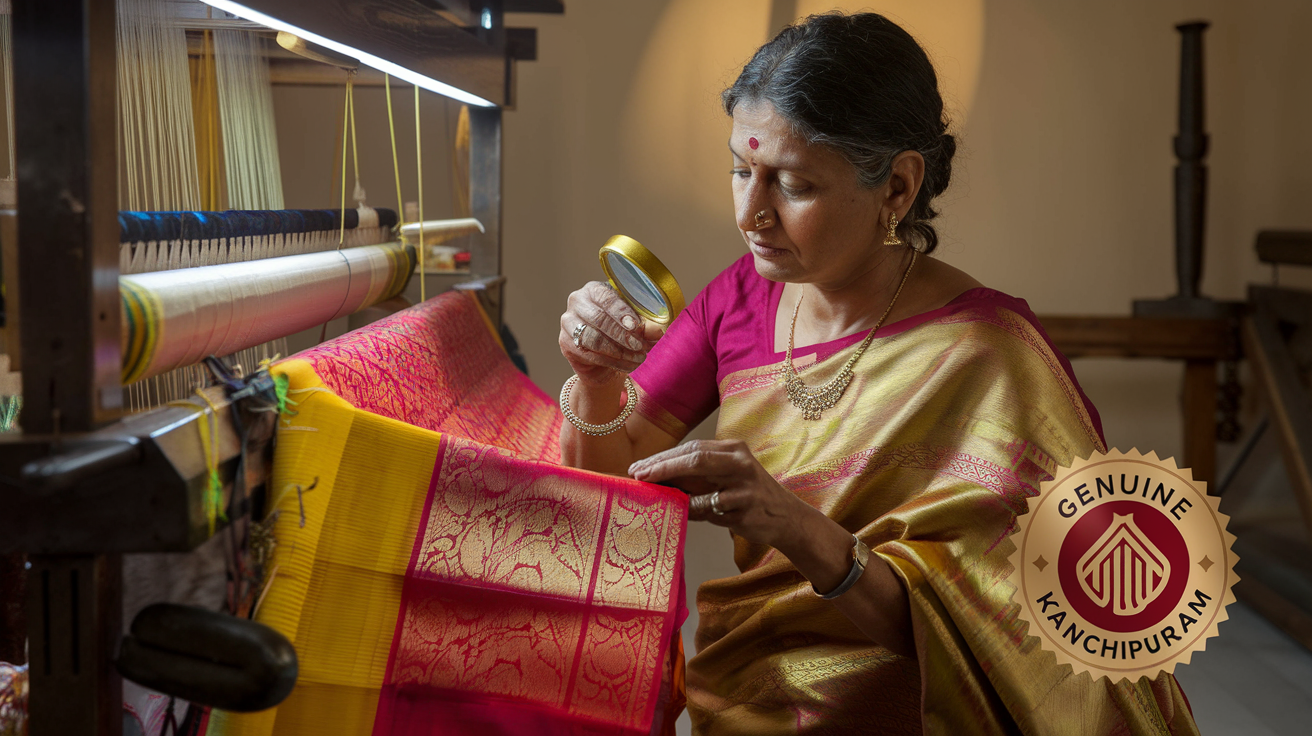
Hallmarks of genuine Kanchipuram silk
Now that we’ve explored the secrets behind Kanchipuram saree making, let’s delve into how to identify authentic Kanchipuram sarees. Recognizing genuine Kanchipuram silk is crucial for preserving the art and supporting the traditional weavers. Here are the key hallmarks to look for:
- Zari Thread: Authentic Kanchipuram sarees use pure gold or silver zari threads for their intricate designs. The zari should have a distinct luster and weight.
- Double Warp: Genuine Kanchipuram silk features a unique double warp weave, making the fabric thicker and more durable than other silk sarees.
- Contrasting Pallu: A hallmark of Kanchipuram sarees is the contrasting pallu, often featuring a different color or design from the body of the saree.
- Heavy Weight: Due to the use of pure silk and zari, authentic Kanchipuram sarees are heavier than imitations.
- Border Characteristics: The border of a genuine Kanchipuram saree is woven separately and then attached to the body, creating a distinct joint.
- Silk Texture: Pure Kanchipuram silk has a unique texture – slightly crisp yet soft to the touch.
- Color Fastness: The dyes used in authentic Kanchipuram sarees are of high quality, ensuring color fastness even after multiple washes.
- Price Point: Given the quality of materials and craftsmanship involved, genuine Kanchipuram sarees are typically more expensive than imitations.
To better understand these hallmarks, let’s compare them with characteristics of imitation sarees:
| Characteristic | Authentic Kanchipuram Saree | Imitation Saree |
|---|---|---|
| Zari Thread | Pure gold or silver | Synthetic or copper |
| Weave | Double warp, thick | Single warp, thin |
| Pallu | Contrasting, intricately designed | Often matching, less detailed |
| Weight | Heavy | Lightweight |
| Border | Separately woven and attached | Printed or woven with the body |
| Texture | Crisp yet soft | Smooth, often slippery |
| Color | Rich, fast colors | May fade after washing |
| Price | Higher | Lower |
Common imitations to watch out for
As the demand for Kanchipuram sarees has grown, so has the market for imitations. Being aware of these common imitations can help you avoid purchasing counterfeit products:
- Art Silk Sarees: These are made from artificial silk fibers and often marketed as ‘Kanchipuram-style’ sarees. While they may look similar, they lack the durability and luster of genuine Kanchipuram silk.
- Printed Silk Sarees: Some manufacturers print Kanchipuram-like designs on plain silk sarees. These lack the intricate weaving and zari work of authentic pieces.
- Powerloom Sarees: Machine-made sarees that mimic Kanchipuram designs but lack the craftsmanship and quality of handwoven pieces.
- Blended Silk Sarees: These sarees use a mix of silk and synthetic fibers, compromising the pure silk quality of genuine Kanchipuram sarees.
- Zari Imitations: Instead of pure gold or silver zari, imitations often use synthetic threads or copper coated with gold color.
To avoid falling prey to these imitations, consider the following tips:
- Purchase from reputable sellers or directly from recognized Kanchipuram silk cooperatives
- Examine the saree closely for the hallmarks mentioned earlier
- Check for certifications and geographical indication tags
- Compare prices – if a deal seems too good to be true, it probably is
- Feel the texture and weight of the saree – authentic Kanchipuram silk has a distinct feel
Certification and geographical indication status
To protect the authenticity and legacy of Kanchipuram sarees, several measures have been put in place:
- Geographical Indication (GI) Tag: In 2005, Kanchipuram silk sarees were granted a Geographical Indication tag. This certification ensures that only sarees produced in the Kanchipuram region using traditional methods can be sold under the Kanchipuram silk name.
- Silk Mark: The Silk Mark Organization of India issues the Silk Mark label, which guarantees that a product is made of pure silk. Look for this label when purchasing Kanchipuram sarees.
- Handloom Mark: This certification, issued by the Ministry of Textiles, Government of India, verifies that a product is genuinely handwoven.
- Co-operative Society Certification: Many authentic Kanchipuram sarees are produced by government-recognized co-operative societies. These societies often provide their own certification of authenticity.
The importance of these certifications cannot be overstated. They not only protect consumers from imitations but also safeguard the livelihoods of traditional weavers and the cultural heritage of Kanchipuram silk weaving.
When shopping for Kanchipuram sarees, always ask for and verify these certifications. Reputable sellers will be happy to provide this information and documentation.
It’s worth noting that while these certifications are crucial, they should be considered alongside the physical characteristics of the saree. A holistic approach to authentication, combining certification checks with a thorough examination of the saree’s features, is the best way to ensure you’re purchasing a genuine Kanchipuram silk saree.
By being informed about the hallmarks of authentic Kanchipuram sarees, understanding common imitations, and knowing about certification processes, you can make confident purchases and contribute to the preservation of this timeless weaving tradition. Next, we’ll explore how to care for and preserve these exquisite pieces of art, ensuring they remain as beautiful as the day they were woven for generations to come.
Preserving the Timeless Weave
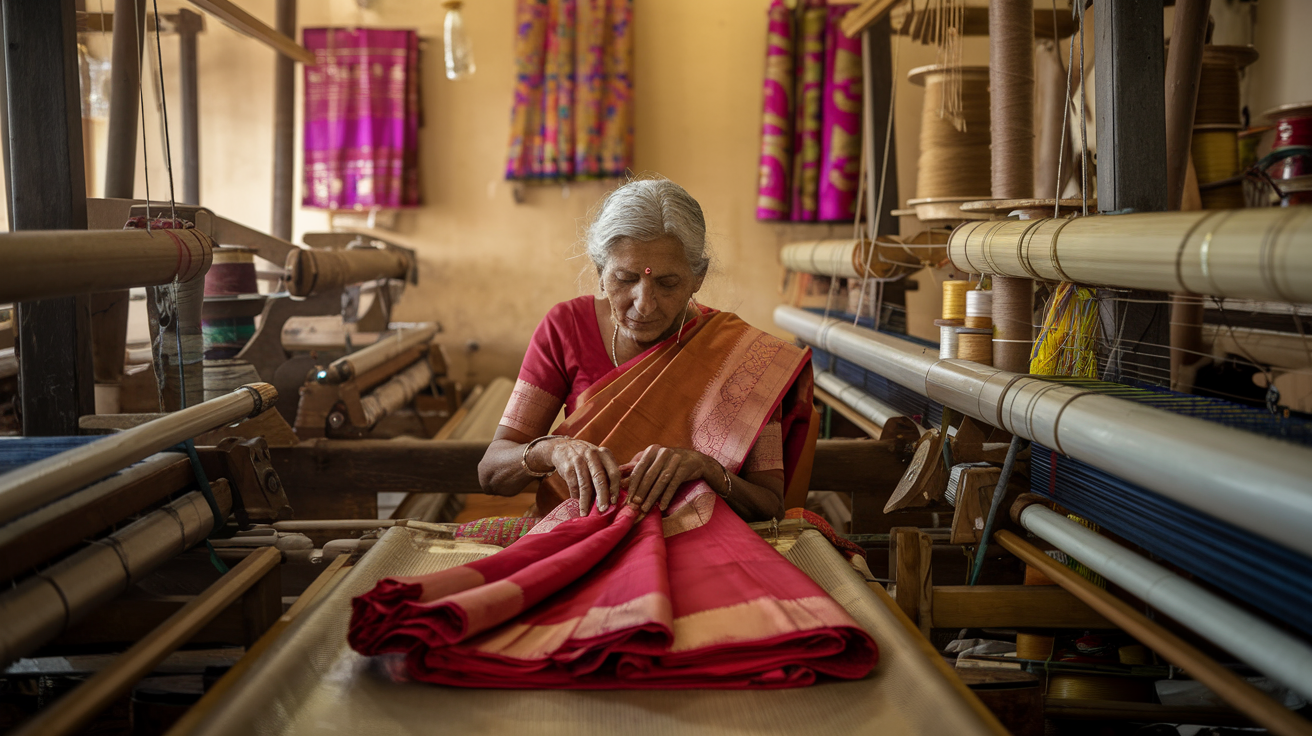
Challenges faced by the industry
The Kanchipuram saree industry, despite its rich heritage and timeless appeal, faces numerous challenges in the modern era. These obstacles threaten the very existence of this traditional craft and the livelihoods of skilled artisans.
- Competition from power looms: One of the most significant challenges is the rise of power loom-produced imitations. These machine-made sarees, while cheaper, lack the authenticity and quality of handwoven Kanchipuram sarees. However, they often confuse consumers and undercut the market for genuine products.
- Declining artisan population: The younger generation is increasingly disinterested in pursuing this labor-intensive craft, leading to a shortage of skilled weavers. This trend threatens the continuity of traditional weaving techniques and patterns.
- Rising raw material costs: The increasing prices of high-quality silk and zari (gold thread) have significantly impacted production costs, making it difficult for weavers to maintain profitability without raising prices.
- Changing consumer preferences: Modern fashion trends and the shift towards Western wear have affected the demand for traditional Kanchipuram sarees, especially among younger consumers.
- Limited innovation: While preserving tradition is crucial, the industry has been slow to adapt to changing market demands and incorporate modern designs, potentially limiting its appeal to a broader audience.
| Challenge | Impact on Industry |
|---|---|
| Power loom competition | Reduced market share, price pressure |
| Declining artisans | Loss of traditional skills, reduced production capacity |
| Rising raw material costs | Increased production costs, reduced profitability |
| Changing consumer preferences | Decreased demand, especially among younger demographics |
| Limited innovation | Reduced appeal to modern consumers, stagnation in designs |
Government initiatives and support
Recognizing the cultural and economic importance of the Kanchipuram saree industry, various government initiatives have been implemented to support and preserve this timeless weave.
- Geographical Indication (GI) tag: In 2005, Kanchipuram silk sarees were granted a GI tag, protecting their unique identity and preventing imitations from being sold under the same name.
- Handloom Reservation Act: This legislation reserves certain textile products, including Kanchipuram sarees, exclusively for handloom production, safeguarding the livelihoods of traditional weavers.
- Cluster development programs: The government has established weaver clusters in Kanchipuram and surrounding areas, providing infrastructure, training, and marketing support to artisans.
- Skill development initiatives: Various programs aim to train young artisans in traditional weaving techniques, ensuring the continuation of this craft.
- Financial assistance: Schemes like the Weavers Credit Card and MUDRA loans provide easy access to credit for weavers, helping them invest in raw materials and equipment.
- Marketing support: Government-sponsored exhibitions and e-commerce platforms like e-Dhaga help weavers showcase and sell their products directly to consumers, eliminating middlemen.
- Research and development: Institutions like the Central Silk Board conduct research on improving silk quality and developing eco-friendly dyeing techniques, benefiting the Kanchipuram saree industry.
These initiatives have played a crucial role in supporting the Kanchipuram saree industry, but continuous efforts are needed to address evolving challenges and ensure the craft’s long-term sustainability.
Modern adaptations and global appeal
To remain relevant in the contemporary fashion landscape, the Kanchipuram saree industry has embraced various modern adaptations while maintaining its core traditional elements. These innovations have helped expand its global appeal and attract a new generation of consumers.
- Fusion designs: Designers are incorporating modern motifs and patterns into traditional Kanchipuram weaves, creating a unique blend of old and new that appeals to younger consumers.
- Contemporary color palettes: While retaining classic combinations, weavers are experimenting with trendy color schemes to cater to evolving tastes.
- Lightweight variants: Responding to the demand for more comfortable and versatile sarees, artisans are creating lighter versions of Kanchipuram silk sarees without compromising on quality.
- Global fashion collaborations: Renowned international designers are partnering with Kanchipuram weavers to create exclusive collections, bringing these sarees to global fashion runways.
- Sustainable practices: The industry is adopting eco-friendly dyeing techniques and sustainable production methods, aligning with global trends in ethical fashion.
- Digital presence: Many Kanchipuram saree brands have established online stores and social media presence, making these exquisite pieces accessible to a worldwide audience.
- Diversification of products: Weavers are applying Kanchipuram weaving techniques to create other products like scarves, stoles, and home decor items, expanding their market reach.
The global appeal of Kanchipuram sarees has grown significantly due to these adaptations. Celebrities and fashion influencers worldwide have embraced these sarees, showcasing them at international events and red carpets. This exposure has heightened interest in Indian textiles and craftsmanship, positioning Kanchipuram sarees as a symbol of luxury and cultural heritage in the global fashion market.
Tips for saree care and maintenance
Proper care and maintenance are essential to preserve the beauty and longevity of Kanchipuram sarees. These valuable pieces of art require special attention to ensure they remain in pristine condition for generations. Here are some expert tips for caring for your Kanchipuram sarees:
- Storage:
- Store sarees in a cool, dry place away from direct sunlight to prevent fading and fabric damage.
- Use soft cotton or muslin cloth to wrap the sarees before storing them.
- Avoid hanging Kanchipuram sarees for long periods, as this can strain the fabric and zari work.
- Cleaning:
- Dry clean Kanchipuram sarees only when necessary, and always use a reputable cleaner experienced in handling silk garments.
- For light stains, gently spot clean with a soft cloth dipped in cold water mixed with a mild detergent.
- Never use harsh chemicals or bleach on your Kanchipuram sarees.
- Ironing:
- Iron Kanchipuram sarees on low heat, using a clean white cloth between the iron and the saree.
- Avoid ironing directly on zari work to prevent damage to the delicate threads.
- Folding and refolding:
- Regularly refold stored sarees to prevent permanent creases and damage to the fabric.
- Change the folding pattern every few months to distribute stress evenly across the fabric.
- Airing:
- Periodically air out your Kanchipuram sarees in shade to prevent mustiness and maintain fabric freshness.
- Avoid exposing the sarees to direct sunlight during this process.
- Pest protection:
- Use natural moth repellents like neem leaves or lavender sachets to protect your sarees from insect damage.
- Avoid using naphthalene balls, as they can damage the silk fabric and zari work.
- Wearing and handling:
- Be mindful of jewelry that might snag on the delicate fabric while wearing the saree.
- Avoid spraying perfumes or deodorants directly on the saree, as they can stain the fabric.
| Care Aspect | Do’s | Don’ts |
|---|---|---|
| Storage | Use soft cotton wraps, store in cool dry place | Hang for long periods, expose to sunlight |
| Cleaning | Dry clean when necessary, spot clean gently | Use harsh chemicals or bleach |
| Ironing | Use low heat, place cloth between iron and saree | Iron directly on zari work |
| Folding | Refold regularly, change folding pattern | Leave folded in same pattern for long periods |
| Pest Protection | Use natural repellents | Use naphthalene balls |
By following these care instructions, you can ensure that your Kanchipuram sarees retain their luster, color, and intricate designs for years to come. These timeless pieces of art are not just garments but investments in cultural heritage, deserving the utmost care and respect.
Now that we have explored the challenges, government initiatives, modern adaptations, and care tips for Kanchipuram sarees, let’s address some frequently asked questions about these exquisite textiles. These FAQs will provide further clarity on various aspects of Kanchipuram sarees, helping enthusiasts and potential buyers make informed decisions.
FAQs on Kanchipuram Sarees
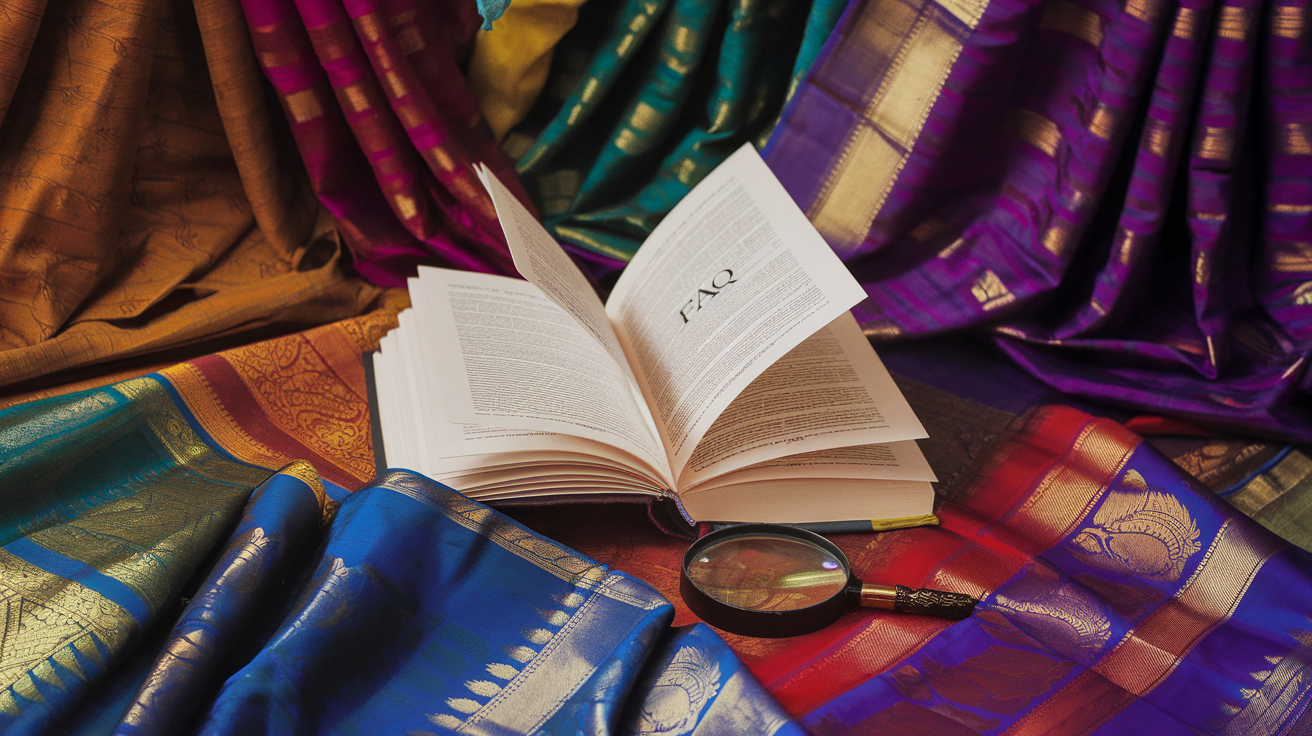
What makes Kanchipuram sarees unique?
Kanchipuram sarees stand out for several reasons, making them a prized possession in every Indian woman’s wardrobe. These sarees are renowned for their:
- Distinctive weaving technique
- Use of pure mulberry silk
- Zari work with real gold and silver threads
- Vibrant and long-lasting colors
- Durability and longevity
The unique aspect of Kanchipuram sarees lies in their weaving process. Unlike other silk sarees, the body and border of a Kanchipuram saree are woven separately and then interlocked, resulting in a saree that can last for generations.
How can I identify an authentic Kanchipuram saree?
Identifying a genuine Kanchipuram saree requires attention to detail. Here are some key factors to consider:
- Weight: Authentic Kanchipuram sarees are heavier due to the use of pure silk and zari.
- Zari work: Real Kanchipuram sarees use zari made of pure gold or silver threads.
- Border: The border is typically woven separately and attached to the body.
- Pallu design: The pallu often features intricate mythological or traditional motifs.
- GI tag: Look for the Geographical Indication (GI) tag, which certifies its authenticity.
To further assist in identification, here’s a comparison table:
| Feature | Authentic Kanchipuram Saree | Imitation Saree |
|---|---|---|
| Fabric | Pure mulberry silk | Artificial silk or mixed fabrics |
| Zari | Real gold or silver threads | Imitation zari or metallic threads |
| Weight | Heavier (500-600 grams) | Lighter |
| Border | Separately woven and attached | Printed or woven as part of the body |
| Price | Higher due to quality materials | Significantly lower |
What is the significance of the motifs used in Kanchipuram sarees?
Kanchipuram sarees are renowned for their intricate motifs, each carrying deep cultural and religious significance. Some common motifs include:
- Peacocks: Symbolizing grace and beauty
- Mangoes: Representing fertility and abundance
- Temple designs: Reflecting the rich architectural heritage
- Rudraksham: Signifying Lord Shiva
- Annapakshi (mythical bird): Representing divine protection
These motifs are not merely decorative but serve as a visual language, telling stories from Hindu mythology and showcasing the cultural richness of South India.
How should I care for my Kanchipuram saree?
Proper care is essential to maintain the beauty and longevity of your Kanchipuram saree. Follow these guidelines:
- Dry cleaning: Prefer professional dry cleaning for the best results.
- Storage: Store in a cool, dry place wrapped in a soft cotton cloth.
- Folding: Avoid hanging; instead, fold with tissue paper between layers.
- Sunlight exposure: Limit direct sunlight exposure to prevent color fading.
- Ironing: If necessary, iron on low heat with a cloth placed over the saree.
Are Kanchipuram sarees suitable for daily wear?
While Kanchipuram sarees are often associated with special occasions, they can be adapted for daily wear:
- Choose lighter weight variants (300-400 grams) for more comfort.
- Opt for sarees with simpler designs and less zari work for a more subdued look.
- Consider half-silk Kanchipuram sarees for a balance of elegance and practicality.
- Pair with simple jewelry for a more casual appearance.
However, it’s important to note that due to their value and craftsmanship, many prefer to reserve Kanchipuram sarees for special events.
How long does it take to weave a Kanchipuram saree?
The weaving process of a Kanchipuram saree is intricate and time-consuming. Here’s a breakdown:
- Simple designs: 10-15 days
- Medium complexity: 20-25 days
- Highly intricate designs: Up to 60 days
Factors influencing the weaving time include:
- Complexity of the design
- Amount of zari work
- Skill level of the weaver
- Type of motifs used
This lengthy process contributes to the saree’s value and explains its higher price point compared to machine-made alternatives.
Can Kanchipuram sarees be customized?
Yes, Kanchipuram sarees can be customized to suit individual preferences. Customization options include:
- Color combinations
- Motif selection
- Zari work intensity
- Border width and design
- Pallu elaboration
However, customization may increase the production time and cost. It’s advisable to work with reputable weavers or established retailers for custom orders to ensure quality and authenticity.
What is the future of Kanchipuram saree weaving?
The future of Kanchipuram saree weaving faces both challenges and opportunities:
Challenges:
- Declining number of skilled weavers
- Competition from machine-made imitations
- Rising costs of raw materials
Opportunities:
- Increased global recognition and demand
- Government initiatives to support handloom sector
- Innovation in designs to appeal to younger generations
- E-commerce platforms expanding market reach
Efforts are being made to preserve this art form through:
- Training programs for new weavers
- Technological interventions to ease the weaving process
- Promotion of Kanchipuram sarees as luxury fashion items
Are there any alternatives to silk for those seeking cruelty-free options?
For those looking for cruelty-free alternatives to traditional silk Kanchipuram sarees, several options are available:
- Ahimsa Silk: Also known as peace silk, this is produced without harming silkworms.
- Art Silk: Made from artificial fibers but mimics the look of silk.
- Cotton-Silk Blend: Combines the comfort of cotton with the sheen of silk.
- Bamboo Silk: An eco-friendly option with a silk-like texture.
While these alternatives offer similar aesthetics, they may not replicate the exact texture and durability of traditional Kanchipuram silk. However, they provide ethical choices for conscious consumers.
Now that we’ve addressed these frequently asked questions about Kanchipuram sarees, you have a comprehensive understanding of their uniqueness, care, and cultural significance. This knowledge will help you appreciate the artistry and tradition behind each Kanchipuram saree, whether you’re purchasing one or simply admiring this timeless weave.
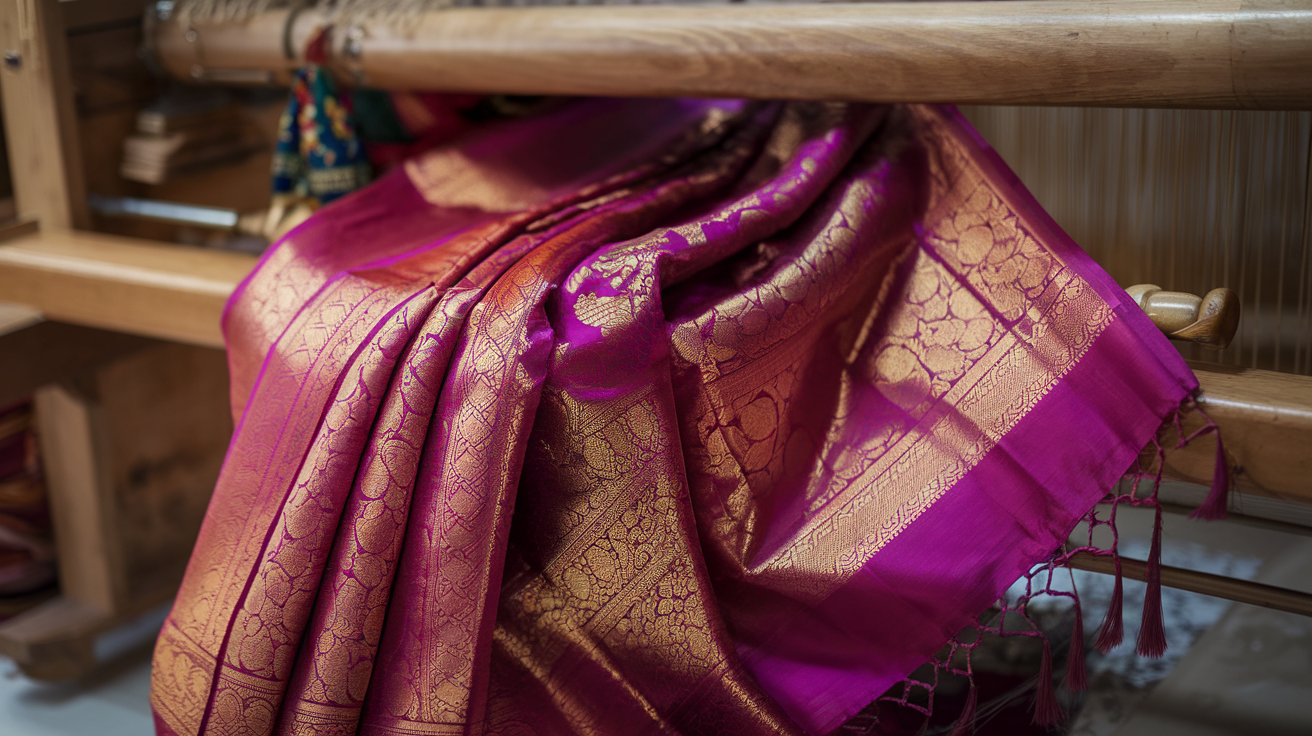
Kanchipuram sarees stand as a testament to India’s rich textile heritage, embodying centuries of artistry, science, and tradition. From their intricate weaving techniques to the use of pure silk and zari threads, these sarees represent the pinnacle of craftsmanship. The unique characteristics of Kanchipuram sarees, such as their durability, distinctive borders, and motifs, make them a prized possession for generations.
As we strive to preserve this timeless weave, it is crucial to support authentic artisans and understand the hallmarks of genuine Kanchipuram sarees. By appreciating the art, science, and secrets behind these magnificent garments, we can ensure that this cultural treasure continues to thrive and inspire future generations. Embrace the legacy of Kanchipuram sarees and become a part of their enduring story.

